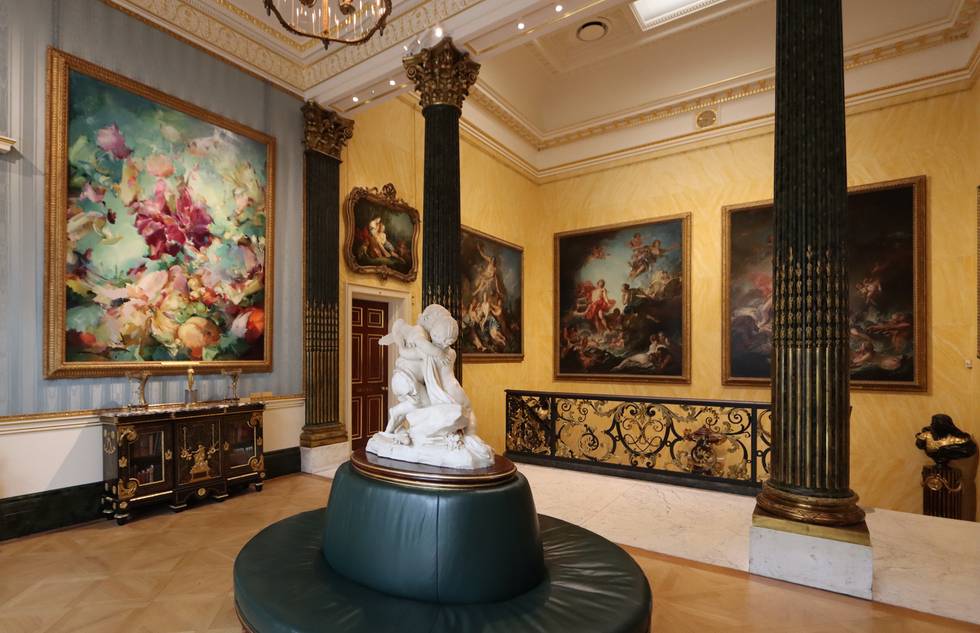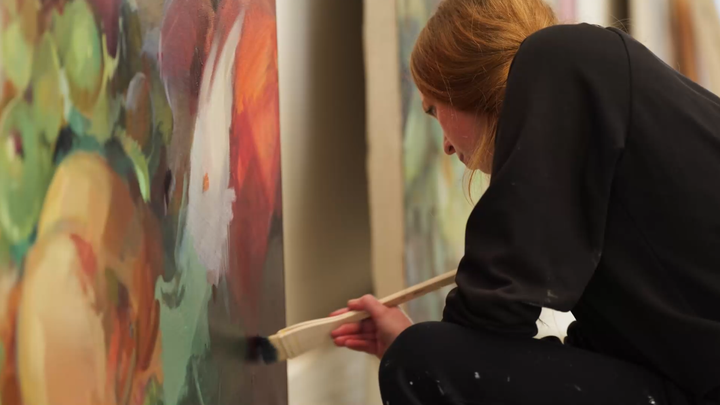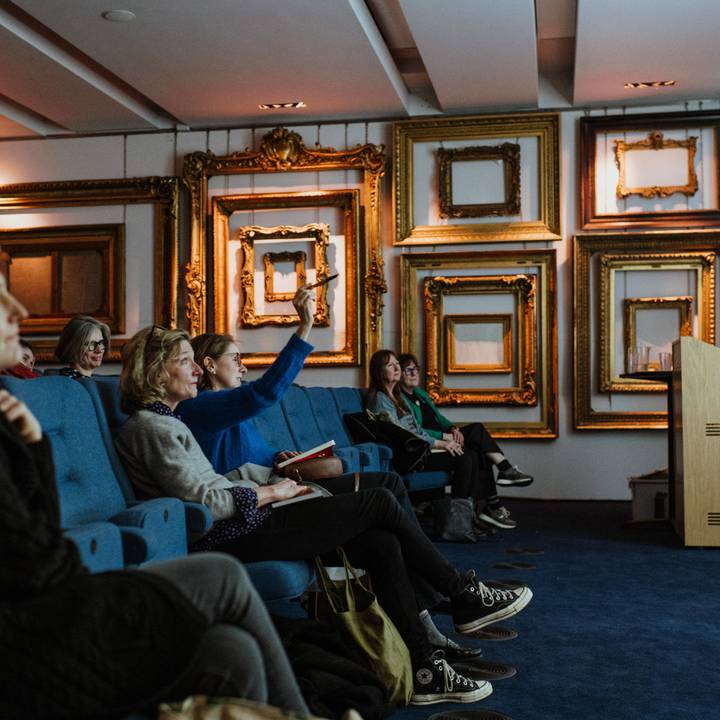The invitation to the contemporary British artist Flora Yukhnovich (1990) to respond to two masterpieces by François Boucher (1703–1770) in the Wallace Collection not only welcomes a major artist to the museum, but creates an opportunity to look at Boucher’s work afresh.
The artist’s large-scale paintings of 1749, Pastoral with a Couple near a Fountain and Pastoral with a Bagpipe Player, which usually hang opposite each other on the landing at the top of the grand staircase, are for the very first time being exhibited out of their frames, downstairs in the Collection’s temporary exhibition space.
Here, hung against white walls like contemporary works of art and at a much lower height than usual (and without the usual precious furniture, clocks and porcelain in the way), it is possible to examine Boucher’s paintings in much greater detail than usual.
What becomes clear when getting close to these two pictures are the many reasons why Boucher was such a sought-after artist. For instance, looking at the cow and the goat in the bottom left-hand corner of Pastoral with a Bagpipe Player it is easy to see how Boucher brings light-hearted good humour to his accurate yet characterful animals.
He’s also clever in the way he uses them. The beasts both address the viewer whilst appearing comically unimpressed by the goings-on of the human protagonists nearby.
They also do a great job of establishing recession in the picture, with the goat introducing an important area of light in an otherwise dark corner.
Boucher’s bold handling of colour and skillful manipulation of paint also dazzles when seen close up. In the basket of grapes in Pastoral with a Couple near a Fountain, for example, he edges the vine leaves with bright touches of red and yellow, and rings the grapes with sweeps of orange and pale blue to make them appear both juicy and translucent.
These are techniques Boucher may well have picked up when creating sets for the theatre (where colours and forms have to be read over considerable distances) and when submitting designs for tapestries in which colours are woven in discrete blocks rather than blended like oil paints.
In painting, Boucher was well aware of the competition his pictures would be up against in the colourful environment of contemporary 18th-century interiors. It’s also clear he thought about how much his art should complement the stylistic language of the Rococo decor that would surround it.
The Wallace Collection pastorals originally belonged to a high-ranking civil servant, the governor of the Auvergne, Charles-Daniel Trudaine, who hung them in the grand salon of his country house at Montigny-Lencoup near Fontainebleau. This idea of Boucher creating works in dialogue with an environment is an aspect of Boucher’s art that Yukhnovich finds very compelling.
I think what I found most interesting about Boucher's work, when I was thinking about how to respond to these paintings, was that idea of the decorative languages in the Wallace collection finding their way into Boucher's paintings and sort of coming back out again where leaves look like scrollwork, and that conversation goes across different mediums. (Yukhnovich, 2024)

While Boucher will come out of his usual frames and be hung downstairs, two new semi-abstract paintings made in direct response to the pictures by Yukhnovich will take Boucher’s place on the Wallace Collection landing.
Each of Yukhnovich’s paintings are of exactly the same dimensions as the originals and both will sit in copies of the gilt frames that surround the 18th-century pictures. It’s a completely new venture for Yukhnovich who has never had her work framed, let alone placed within the context of a largely 18th-century collection.
We've called this display ‘The Language of the Rococo’. And for me, it's going to be very exciting to see the paintings in this sort of wide decorative scheme and look at the way the language of the Rococo feeds into the paintings and out into the decorative objects and see how the frame activates the painting and what the context does to my work. (Yukhnovich, 2024)
One, titled A World of Pure Imagination, after the song in the 1971 film Willy Wonka and the Chocolate Factory, includes the scrolled acanthus leaves and fruits and flowers so often used in Rococo decorative arts over which a cow leaps in the sky and a Boucher-styled goat and donkey quietly much their way through the foreground cornucopia.
Researching these pastoral paintings, I was so excited to learn about Boucher's relationship with the theatre… And I hope that when people see my work, they feel that it's sort of a step on from that… where I'm pulling in lots of different types of imagery from different sort of places, whether it's film or from adverts. (Yukhnovich, 2024)
The other, titled Folies Bergère which could be translated as ‘Shepherdess Madness’, includes the abstracted figures of the shepherd feeding his sweetheart grapes, while the grapes themselves – in the manner of the fantasy landscapes of Disney’s Fantasia or Hieronymus Bosch’s Garden of Earthly Delights – become giant, semi-translucent spheres.
Watch the film below and join Flora Yukhnovich in her studio as she discusses how she created the two breathtaking new works featured in our display. Learn more about her process, from finding inspiration to selecting her vibrant colour palette.




